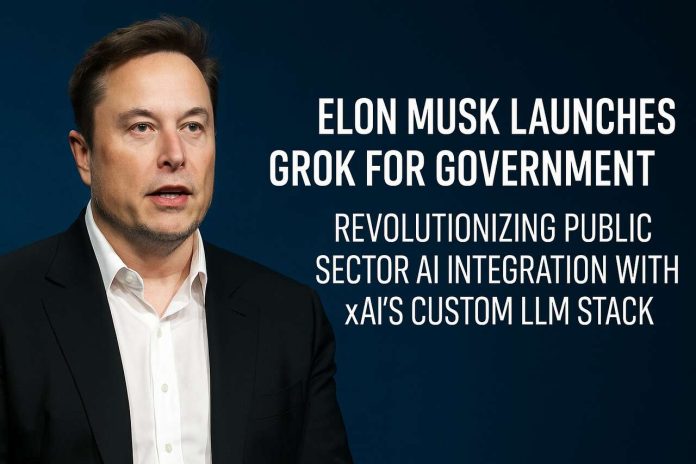What Is Grok for Government and Why Does It Matter for Public Sector AI Adoption?
Grok for Government is a specialized deployment of Elon Musk’s xAI large language model (LLM) platform, tailored to meet the operational, legal, and security needs of governmental institutions. The initiative strategically aligns generative AI capabilities with the digital transformation goals of public administrations, particularly in regulatory compliance, cybersecurity resilience, and process automation.
Who Is Behind Grok for Government?
The core driving entity is xAI (X.AI Corp), an artificial intelligence company founded by Elon Musk in 2023. The parent company has built proprietary LLMs under the “Grok” brand, positioned as a direct competitor to OpenAI’s GPT, Google’s Gemini, and Anthropic’s Claude.
The government-specific initiative is backed by xAI’s infrastructure integration with X Corp, which provides access to compute via Supercomputer-grade clusters and data streams from X (formerly Twitter) for real-time public discourse modeling.
What Are the Core Features of Grok for Government?
-
Private LLM Deployment: Supports on-premise and sovereign cloud environments for data confidentiality and jurisdictional compliance.
-
Air-Gapped Infrastructure: Ensures isolated deployment with zero internet exposure, meeting top-tier cybersecurity standards such as FedRAMP High and FISMA Moderate.
-
Domain-Specific Fine-Tuning: Adapts Grok’s generative capabilities to legal, bureaucratic, and defense-specific language corpora, improving output relevance for agency-specific mandates.
-
Auditability and Explainability: Incorporates model interpretability features, critical for agencies needing transparent decision trails for accountability.
-
Multi-Modal Support: Enables text, vision, and structured data processing, optimizing government use cases in surveillance, reporting, and citizen service interfaces.
How Does Grok for Government Enhance AI Security and Sovereignty?
Grok for Government uses AI system design frameworks based on zero-trust architectures, multi-layer encryption, and fine-grained access controls. These mechanisms align with strategic national interests in cyber defense and digital sovereignty.
What Cybersecurity Protocols Are Integrated?
Grok deployments comply with government frameworks such as:
-
NIST SP 800-53 for security controls,
-
FedRAMP for cloud service certification,
-
Zero Trust Edge (ZTE) principles to ensure minimal lateral movement,
-
Immutable audit logs to prevent data tampering and enable traceability in inference pipelines.
How Is Sovereignty Maintained in Model Hosting?
The platform offers sovereign LLM hosting options within country-specific data centers, eliminating dependency on foreign infrastructure. Governments can license the model weights and inference engines under restricted-use clauses, ensuring data and decision autonomy.
What Role Does Air-Gapping Play?
By physically isolating servers from external networks, air-gapped deployments prevent data exfiltration and remote injection attacks. This is especially vital for national defense, intelligence, and law enforcement bodies processing classified datasets.
How Is Data Governance Handled?
xAI implements structured policy enforcement layers for:
-
Prompt logging,
-
Dataset lineage tracking,
-
PII redaction before training/fine-tuning,
-
Third-party model audits by certified government contractors.
Which Government Use Cases Will Grok for Government Optimize?
Grok for Government enhances operational efficiency and decision-making across multiple inter-agency domains by providing AI capabilities trained on regulatory lexicons, procedural codes, and case law corpora.
How Does It Support Legal and Compliance Tasks?
Grok enables real-time parsing and summarization of:
-
Legislation drafts,
-
Case precedent databases,
-
Contractual clauses,
-
Using structured legal ontologies for improved retrieval, inference, and policy validation workflows.
How Does It Benefit Citizen-Facing Services?
Government portals integrated with Grok can deliver:
-
Conversational AI interfaces for citizen queries,
-
Multilingual document summarization,
-
AI-driven eligibility triage for public services like healthcare, housing, and taxation.
How Will It Assist in Law Enforcement?
Using multi-modal capabilities, Grok supports:
-
Surveillance video captioning,
-
Automated incident report generation,
-
Predictive analytics for crime hotspots,
-
While ensuring constitutional safeguards through customizable redaction filters and legal boundaries.
Can It Be Used for Emergency Response?
Yes. During crises, Grok can:
-
Aggregate and summarize real-time public data (via X’s social media feed),
-
Generate logistics plans,
-
Model response outcomes,
-
All within frameworks like FEMA’s emergency playbooks and COOP/COG protocols.
Why Does the Grok for Government Launch Matter in the Global AI Race?
The initiative positions xAI and the United States as pioneers in sovereign AI infrastructure, directly challenging similar efforts by China (WuDao), EU’s Gaia-X, and Russia’s GigaChat. It introduces a blueprint for regulatory-aligned AI deployments that balance innovation with control.
How Does Grok Compare with GPT-4 for Government Use?
Unlike GPT-4 (developed by OpenAI and often served via Microsoft Azure), Grok:
-
Offers fully private deployment,
-
Trains on real-time public discourse,
-
Integrates cross-modal intelligence,
-
Allows customizable model weights,
-
Supports non-U.S. governmental frameworks, with local language adaptation.
What Are the Strategic Implications?
Deploying Grok for Government:
-
Strengthens national digital infrastructure,
-
Reduces foreign dependency on AI vendors,
-
Enhances public trust through explainable and auditable AI processes.
Which Countries Are Potential Adopters?
Nations prioritizing digital sovereignty, such as:
-
France,
-
India,
-
Brazil,
-
Germany,
-
Could engage in procurement deals or model licensing for defense and governance purposes.
Conclusion
Grok for Government by xAI represents a paradigm shift in how national institutions can responsibly adopt generative AI. By aligning cutting-edge LLM capabilities with sovereignty, security, and sector-specific utility, the platform sets a new benchmark in public sector AI infrastructure.
